Tea-tribes of Assam
| Tea Garden Workers | |
|---|---|
| Total population | |
|
(5.5-6.0 million (55-60 Lakhs) or 18%-20% of Assam's total population) | |
| Regions with significant populations | |
| Districts of Cachar, Kokrajhar, Udalguri, Sonitpur, Nagaon, North Lakhimpur, Golaghat, Jorhat, Sivasagar, Dibrugarh, Tinsukia. | |
| Languages | |
| Nagpuri • Odia • Santhali • Kurukh • Bengali | |
| Religion | |
| Hinduism • Sarnaism • Christianity | |
| Related ethnic groups | |
| Odia people, Bengalis, People of Central-eastern India |
The Tea Garden Workers of Assam are the conglomeration of descendants of both tribals and backward caste Hindus who were brought by the British colonial planters as indentured labourers from the predominantly Tribal and backward castes dominated regions of present-day Jharkhand, Odisha, West Bengal, Telangana and Chhattisgarh into Assam during 1860-90s in multiple phases for the purpose of being employed in the tea gardens industry as labourers. They are found mainly in the districts of Kokrajhar, Udalguri, Sonitpur, Nagaon, Golaghat, Jorhat, Sivasagar, Dibrugarh, Tinsukia and almost all the districts of Assam in India. The total population of the community is estimated to be around 5.5-6.0 million or about 20 percent of total population of Assam. Santhali speakers are also found in parts of Kokrajhar, Baksa and Bongaigaon districts. They generally use Nagpuri or Sadri having high degree of Odia and Bengali influence as lingua franca among themselves along with use of other tribal languages like Santhali, Kurukh and Mundari. They have their own dance form, Jhumur, which is quite popular in Assam.
Ethnology
Adivasi (Hindi:आदिवासी) is an umbrella term for a heterogeneous set of ethnic and tribal groups considered aboriginal population of South Asia.
History
Immigration into Assam
_(14596118838).jpg)
They immigrated into Assam in several phases from mid-nineteenth century to mid-twentieth century from the tribal heartland of central-eastern India.
The rising anti-British movements across the tribal and backward caste dominated Chottanagpur region and scarcity of cheap labourers to work in the expanding tea industry of Assam led the British authorities to forcibly recruit Tribals and backward caste Hindus as indentured labourers to work in Assam's tea gardens. Thousands of those people recruited as labourers died of diseases during the journey to Assam, and hundreds were killed by the British authorities who tried to flee as punishment of breaching the contracts.
In 1841 first attempt was made by the Assam Company to recruit labourers. In this attempt 652 people were forcibly recruited but due to outbreak of cholera most of them died. Those who survived fled. In 1859 Workmen's Breach of Contract Act was passed. It rescued the tea planters from scarcity of labour by recruitment from outside Assam through contracts. 'Arakattis' or broker were appointed to recruit labour from outside. In 1870 'Sardari' System was introduced to recruit labours.
Conditions of recruitment of labour from Bengal and Bihar were inhuman. 'Arakattis' were resorted to several fraudulences practices and physical force. From 15 December 1859 to 21 November 1861, the Assam Company brought first batch of 2,272 recruits from outside. Out of 2,272 recruits 250 died on the way to Assam. From 2 April 1861 to 25 February 1862, 2,569 people were recruited and sent to Assam in two batches, through the Brahmaputra river route. During the journey 135 died and 103 absconded. Between 1 May 1863 and 1 May 1866, 84,915 labourers were recruited, but 30,000 died by June 1866. From 1877 to 1929, 419,841 recruits entered Assam as indentured labourers. It included 162,188 males, 119,582 females and 138,071 children. From 1938 to 1947, 158,706 recruits came to Assam. They were brought to Assam through three riverine routes, two through Brahmaputra and one through Surma. Debarken Depots were used to carry the bonded labours. Some of the Debarken Depots in the Brahmaputra were Tezpur, Silghat , Kokilamukh, Dibrugarh , etc. Debarken Depots in Surma (Barak) were Silchar, Katigora, Sylhet, Karimganj etc. Labours were brought in the ships, in a condition that was far worse than the animals. Steamers were overcrowded with recruits and it was highly unhygienic. This led to spread of Cholera among the labours and had taken heavy toll on the lives of labours in the journey.
Under the colonial rule of British
After the journey their life in the tea gardens was also pathetic. Planters used to make barracks known as Coolie line for the labourer and these were overcrowded. "Coolie" was a term used by Tea garden authorities to denote Labourers (now considered derogatory by the community). In these barracks each tea garden labourer got hardly twenty five square feet of area for their personal use. Many of the tea gardens insisted on a morning master of the labours. They were not allowed to remain absent in their duty for a single day even when they were unwell. The Labourers did not enjoy any personal freedom at all. Even they were not allowed to meet labourer of another tea garden. Prior permission from the manager of the tea gardens was necessary for marriage of the labourers. In addition to emigrants labours, tea planters also forced labourers to increase the birth rate, so that each garden could garner enough labour force. Abortion was strictly prohibited.
The wages paid to labourers were also very poor. By paying very low wages the tea planters forced the whole of family members to work in the tea garden. From 1865-1881 men labourers were paid ₹5 per month and women ₹4 per month only. The situation remained same up to 1900. It was by an Act of 1901 wages increased to ₹5.5 for men, ₹4.5 for women and children remained same. Whereas, in the early 1880s an unskilled railway construction labourer earned ₹12 to 16 per month (3 times more than tea garden labour).
The tea garden labourers had to suffer from legal bondage. Their lives were governed by the Workmen's Breach of Contract Act (Act 3 of 1859). Under this act a labour was liable to prosecution, and even imprisonment for breach of contract. Inertia, refusal to work and desertion was equally punishable offence and for that they may be flogged physical torture and imprisoned under the various provision of this act. Flogging was common practice in the tea gardens. The then Chief Commissioner of Assam Fuller stated about the condition of labours, "...They were deprived of all their freedom and their derogatory conditions and atrocities remind one of the slave running in Africa and the global slave trade."
In addition to this the tea garden manager heaped severe atrocities on them for mere personal pleasure. A tea garden manager in Darrang district caught a boy, in his attempt of burglary, and he was beaten to death. His dead body was subsequently found with marks which showed that he had been most cruelly beaten. In Cachar district a boy was flogged to death only because he did not salute the European manager. The worst among such incident was the shoot-out and which killed a tea garden labourer by the European planter of the Kharial Tea Estate of Cachar in 1921 due to refusal of the said labour to provide his daughter as a concubine to the Planter for a night. Facing the atrocities many tea garden labourers often become insane. Lots of lunatic were kept in the jail set up at Tezpur, in 1876, for insane people.
Health conditions during colonial times
Thousands of labours died annually due to non-availability of Medical care as the medical system was very poor in the tea gardens of Assam. The gardens did not appoint any doctors. Though Colonial Government tried to bound the tea gardens to appoint, European Medical officers and send Health report to the Government regularly but tea gardens refused to accept it. Most of the gardens didn't have hospitals to treat the ill health labourers. Most of the gardens appointed some trained physicians called LMP (Learned Medical Practitioner) doctor only after 1889, when Berry White Medical School was set up at Barbari, Dibrugarh.
State of Education during colonial rule
Regarding schooling in the tea gardens areas a report was published by a European DPI in 1917-18 that as many as 2 lakhs children of school going age were there lie in the tea gardens of Assam but not even 2% were turned up for primary education. The numbers of the schools and students enrolment were in papers and files only. It is quite clear from the fact that in 1950 there were 5,00,416 numbers of children who could attend the lower Primary schools but there were only 29,361 children attended the primary schools. It was just meagre 6%. During the period 1946-50, there was only four college students from tea gardens. Number of students attended high schools, included M. E. schools, during this period was, Jorhat - 29, Dibrugarh - 15, Golaghat - 22, Titabor - 04, Nagaon - 10, Lakhimpur - 12, Tezpur - 41 and Mangaldai - 05.
The tea planters never encouraged education to garden labourers as it would prevent them from physical labor or may protest against exploitation. Even after the independence, the amount spend for tea garden education in the first five-year plan was just 0.26 million (2.6 lakhs) .i.e. not even ten paisa per tea garden labourer.
The medium of instruction was also created problems in the tea gardens. Different tribes and castes had their own language and literature in the school owing largely to their original places. In tea gardens, three languages were primarily spoken by the labours, viz. Santhali, Kurukh, Mundari. But commonly "Sadri" was used and outside the tea gardens they used to speak in Assamese language as a medium of communication. Therefore, Narayan Ghatowar, a prominent intellectual of the community advocated that Assamese be imparted in the schools only by "Sadri" knowing Teachers.
Participation in Indian Independence Movement
Though the community remained oppressed primary as a Plantation labourers, they still had the anti-colonial anti-British attitude alive in their mindset.
Noted Historian Amalendu Guha remarks, "Illiterate, ignorant, unorganised and isolated from their homes as they were, the plantation workers were weak and powerless against the planters". But still several times they tried to protest against the atrocities of the planters and Estate managers. For example, protest of 1884 in Bowalia T.E., Strike of Helem T.E. in 1921, etc. But most of them were ruthlessly suppressed. The tea garden labourers never got any form of help or encouragement from Upper Caste Hindu dominated Indian National Congress leaders of Assam. Congress leaders of Assam never tried to extend the course of the Indian Freedom Movement to the tea gardens instead in many cases they helped the planters to suppress the unrest or upsurge labourers of the tea gardens. A splendid example of this kind was the incident of the Kacharigaon T.E at 1921 in Sonitpur . At that time Non-Cooperation movement was going on against the British but the Congress leaders of Assam supported the British to quell the labour unrest, against the planter's atrocities. The Congress leaders through a telegram agreed to cooperate and return British D.C. of Tezpur, Lainee arranged a tea party for the Congressmen for their help.
Another example of Congressmen apathy towards the community can be cited here. Arjun Ghatowar, "an ex-labourer" of Dibru-Darrang T.E. actively participated in Freedom Movement and used to visit Congress office at Dhekiajuli regularly. But Congressmen never encouraged him to organize the movement in the tea garden areas. Chanoo Kharia, who was the first matriculate from the community condemned the local caste Assamese speaking Hindus to treat the mostly Tea-tribe community as untouchable in a meeting in 1934.
Though they were neglected, numbers of persons from the community actively participated in the Indian Independence movement. Some of the names of the participants are, Gajaram Kurmi, Pratap Gond, Shamburam Gond, Mohanchal Gond, Jagamohan Gond, Bidesh Kamar Lohar, Ansa Bhuyan, Radhu Munda, Gobin Tanti, Ramsai Turi, Bishnu Suku Majhi, Bongai Bauri, etc. Some of the Freedom fighters who became martyrs are Doyal Das Panika, Mongol Kurku, Tehlu Saora and Bankuru Saora. Malati Mem alias "Mangri" Oraon became the first ever woman martyr of Assam. The names of these tea garden labourers never got any importance in the histography, but as Guha quoted "it must be admitted that these Adivasis joined in the Indian Independence movement not because of the Assamese middle class, the Congress or the Assamese non-state organizations, but inspite of them."
Demographics

An ethno-linguistic minority, the population of the community is primarily rural in nature and estimated to be near 6 million (60 lakhs) or 18% of Assam's total population as of 2011.
They live in almost every district of Assam but their density varies according to the number of tea plantations in different regions of Assam. They are more numerous in Upper Assam and Central Assam than Lower Assam. Some were not brought for tea garden labour. Many tribes (most notably Santhal, Kurukh and Munda people) were forcibly displaced by the British from the Chotanagpur region due to their rebellion against the British regime. They were dumped into Lower Assam regions of then undivided Goalpara and undivided Darrang districts as a punishment for their uprising against the regime (Santhal rebellion of the 1850s).

The community dominates the districts of Upper Assam including Sonitpur due to high density of tea gardens and plantations in this region. Districts of North Lakhimpur, Darrang, Barak Valley areas and Bodoland Territorial Area District (BTAD) areas of Assam also have significant population of the community. They form nearly 17% and 11% of the total population in BTAD and Barak Valley region respectively.
Different political parties appeal to them during election seasons in Assam as their demographic numbers always influence politics in Assam.
They are not a single ethnic tribe but are the people of various origins, composed of dozens of tribes and castes who have now got intermixed and are interdependent to each other and are closely knitted. Major tribes and communities among them are the Munda, Santhals, Kurukh (Oraon), Gonds, Kharia, Tanti, Saora, Kudumi Mahato, Bhumij, Lohar/Karmakar, Mahali, Khonds, Ho, Chik Baraik, Teli, Turi and dozens of other motley groups of tribes and castes.
Languages

Nagpuri or Sadri is their first language, and this dialect of Hindi works as a lingua franca among them. But the dialect spoken in Assam is totally different to the tone spoken in Chotanagpur region because the tone spoken in Assam is heavily influenced by the Bengali and Assamese language and in some lesser extent by the Odia. Santhali, Mundari, Kurukh, Oriya, Saora and Kharia are also spoken by few segments of the community. The population of Santhali speakers and Odia speakers are over 300,000 each. With steady rise in literacy level newer generations are becoming fluent in standard Hindi, Assamese and English.
Religion
| Religion | Percentage | Sect | |
|---|---|---|---|
| Hinduism | 45% | Shaktism, Vaisnavaite | |
| Christianity | 20% | Roman Catholics, Baptist, Lutheran | |
| Sarnaism | 35% |
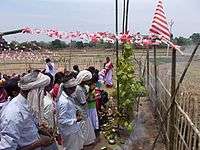
The majority of the population of the community follows Folk Hinduism and Sarna while Christianity is followed by about 20% of the population.
Hindus worship different deities during different seasons of a year. Most of the Hindus are animistic in nature and worship tribal Gods. The influence of mainstream vedic Hinduism is minimal and animistic-Shaktism dominates in religious practices.
The ancient tribal religion Sarnaism is also deeply rooted among them. They believe in a universal supreme God called Dharmesh and worship him/her in different names like Marangburu, Mahadeo and Singbonga. Sarhul Puja and Karam Puja are the prominent festivals of Sarnaism.
Vaishnavism is also steadily gaining footholds among the Hindu population of the community.
They are very religious-minded people and love to worship nature. Many trees are considered sacred and are worshipped. Nearly every village has religious temples and sacred ground (sthal) for community worship.
However increasing conversions into Christianity have led many of them into adopting Christianity and many churches have been built as a result. Nearly one million Adivasis are now Christians in the state. Kurukh, Santhals and Mundas are among the major tribes who have been mostly converted by the Christian missionaries. Roman Catholicism and Protestantism are the major denomination among the Adivasi Christians.
Festivals
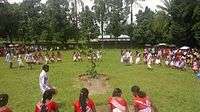
Festivals are an important part of their life and are generally deeply connected to their religion and their culture. They celebrate many festivals during different seasons. Almost every major Hindu festival is celebrated by the community, with Christians celebrating Christian festivals.
Major festivals celebrated by the community are Durga Puja, Diwali, Tusu Puja, Holi, Karam (festival), Sohrai, and Christmas.
Music and dances
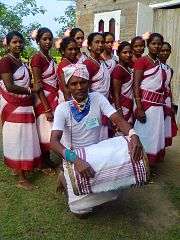
Music is an important component of the community. Their music is usually collectively performed for a variety of occasions like weddings, festivals, arrival of seasons, ushering-in of new life, and harvests. The community is rich in a variety of music and dances. Through the folk music and dance, they try to convey their perspective on social issues and define their daily life styles and their history. In some dance forms, martial arts are displayed to convey their age-old rebellion against the British.
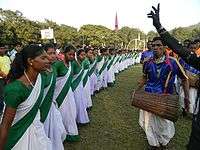
Dhol, Manjira, Madar, Kartal, Tamak, Nagara, Nishan, Bansuri are some of the musical instruments used by them.
'Jhumur dance' is a famous folk dance form of the Tea-tribe community through which they are identified with in Assam. But they also possess other numerous dance forms like Santhali dance, Chhau dance, Karam naach, and Kharia dance which are performed during different occasions.
Jhumur dance

Jhumur is a form of dance performed by girls and boys together, or, sometimes by the girls alone, with precision of footwork while clasping tightly each other's waist. This dance form has its origin in the Central Indian Tribal dance forms prevalent in Jharkhand, Odisha and West Bengal and brought by the community along with them into Assam.
Dhol, Mandar, and Kartal are the traditional musical instruments used during the dance for music. Usually traditional dress of Red bordered white saris are adorned by female dancers along with jewellery and ornaments before performing the dance. Male dancers wore Dhoti and kurta with a white turban in their head.
Socio-economic conditions

They are one of the most backward and exploited community in Assam due to decades of continuous exploitation by Tea garden managements and neglects in part of Government. Though newer generation are comparatively educated and now have intellectuals and professionals in various fields but their percentage is low in comparison to the size of the community.
The literacy rate of the community is one of the lowest in Assam particularly among the girls and women. Due to this, girls are extremely vulnerable to sexual exploitation and early marriages are prevalent among them.
Majority of the population of the community still being labourers, live in labour lines, built inside tea-estates (established by tea planters). These estates are located in interior places and this contributes to the backwardness and exploitation of them by the tea planters. The labourers in a way have to live with the basic facilities provided by the tea planters. The tea planters usually exploit the workers every possible way. Violence and agitation of labourers against the management is common, where the state machinery normally protects the tea-planters. Non-education, poverty, addiction of males to country-beer, poor standard of living, rising population and inadequate health facilities provided to them are the problems in their life. There are instances when tea-planters do not even supply the life-saving drugs when workers are dying out of epidemics.
This has led many labourers to leave tea garden related jobs and relocate in nearby areas outside tea gardens in search of better livelihoods. Many of them have now taken up farming and its related jobs, works in the field of construction and small businesses as livelihood to sustain themselves like any other communities of Assam. In recent times, many young men of the community, particularly from 'bastis' or villages, are migrating temporarily towards Southern India and Gujarat for better economic prospects. From there they send money back home to Assam. It also has started to bring awareness among the youths of the community which will not be possible if they remain toiling in tea gardens.
Rise of "Tribal" identity movement
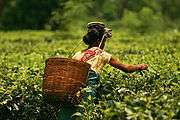
Tea industry is the crucial part of Indian economy. Assam produces 55% of India's total production of tea. It is a labour-intensive industry and highly dependent on a large workforce. It is the only sector where majority of the workers are female.
About two million labourers are dependent on Assam’s tea industry and almost all of whom are the descendants of those who were brought to Assam as labourers by East India Company, mostly from Jharkhand and Orissa. The sacrifice, toil and hard work of these labourers gave shape to the tea industry of Assam. However, the story behind the tea cultivation, plucking and processing of tea leaves in the plantations is one of exploitation and untold hardships for the tea labourers. These labourers are still living with the basic facilities provided by the tea planters or companies. Poor standard of living and lack of education and health facilities are main problems of tea labourers.
Literacy level among the community is one of the lowest in Assam as tea garden management and other vested interests hinders in their educational development. That is why many young people of the community are not choosing tea garden related jobs. This is giving rise to silent Jharkhand like Tribal identity movement among some sections of the community.
Demand of Scheduled Tribe status and other issues
The people of the community have been fighting for decades to receive Scheduled Tribe (ST) status, which is being denied to them in Assam although in other states of India their racial counterparts fully enjoy that status.
The community is composed of many large tribes who are original inhabitants of India like Munda, Santhal, Kurukh (Oraon), Gonds, Bhumij and dozen others who are being denied Scheduled Tribe status.
Assam is the only state in India where these aborigines has been denied ST status. This has given rise to "Tribal" identity politics among these people in Assam and different political parties are banking on this issue to get votes of the community for decades during elections.
Now some of tribes of this community has started to demand ST status separately in order to fulfill the Constitutional criteria designating "Scheduled Tribe".
According to S.D. Pando, one of the three members of a panel set up by the Assam government to write an ethnographic report on the community, Among the 96 ethnic groups who are listed as 'Tea tribe' in Assam, 36 are recognised as ST, 27 as Scheduled caste and the rest are OBCs in other parts of India.
Numerous agitations and movements has been organised and are ongoing demanding ST status and most infamous of them was the Beltola incident of Guwahati happened on 24 November 2007 where public rape and killings in the daylight occurred which had rocked India particularly Assam.
Several peaceful protests and movements are now ongoing in demand of ST status and as a result, central government (NDA) elected in 2014 General Election has formed a task force to accord "Scheduled Tribe" status to at least 26 tribes of this community.
Increase in wage issue
Issue of wage is another issue gripping the majority members of this community. They are demanding increase in daily wages of tea garden workers of the state from existing daily wage of mere ₹94 to ₹330.
As cited, ₹94 as daily wage for tea garden workers did not fulfil the provisions of the Minimum Wage Act, 1948, as it is below the Assam government's prescribed minimum wage (₹169). Wages in tea gardens of Barak Valley is even meagre (₹78 per day). And also according to the Plantation Labour Act, 1951, and Minimum Wage Act, 1948, costs associated with housing, medical and electricity could not be included as part of minimum wages.
Southern states of India has been successful in increasing daily wages of tea garden workers while maintaining the Industry profitable. Daily Wage is ₹254 in Kerala.
It is estimated that 10 lakhs (1 million) labourers working in over 850 tea gardens are deprived of their right of minimum wages in Assam.
According to Krishak Mukti Sangram Samiti, an influential peasant union active in Assam, tea garden management spends only ₹3.6 every day as ration cost for the workers in place of ₹75 (minimum wage minus existing wage or ₹169-₹94) because they procure it in subsidised rate from Central Government funded Food Corporation of India.
It means that garden managements are collecting an additional amount of ₹71.30 each day from the workers which turns out to be ₹1713.60 a month.
It has been estimated that by not providing minimum wage, Tea garden managements loots ₹15 crores per day from tea garden workers that comes as $900 millions or ₹5400 crores per year as a whole.
Persecution
Persecution of the community is mainly political and ethnic in nature. They are increasingly becoming the victims of volatile social and political situation in Assam. The violence upon the community has risen following the rise of ethnic nationalism and related militancy across the state and violent arising out of border disputes of Assam with other states. Hundred of innocent Adivasis has lost their life and thousands rendered homeless in the Bodoland Territorial Area District of Assam due to armed attacks by pro-Bodo militants starting from the 1990s who are in a bid of ethnic cleansing the region to create a Bodo majority Bodoland. Thus it makes the community one of the most vulnerable to frequent violent attacks upon them in Assam.
- In 1996, at least 200 Adivasi lost their life due to attacks by pro-Bodo NDFB militants which led to Bodo-Adivasi clashes in the districts of Bongaigaon and Kokrajhar at the height of violent Bodoland movement. Nearly 0.4 million (4 lakhs) people were internally displaced due to the attacks and clashes. Ethnic cleansing of Adivasis by the NDFB militants for the creation of Bodoland is cited as a reason for the attacks.
- In 1998, at least 100 Adivasi again lost their lives in repeated attacks during the months of May–September by NDFB militants in the district of Kokrajhar which again led to Bodo-Adivasi clashes. About 0.2 million people got displaced due to the clashes this time.
- In July 2002, NDFB militants massacred 9 Adivasis and injured 5 others in Kokrajhar district.
- In November 2007, five Adivasi lost their lives and at least 250 injured when a rally in demand of Scheduled Tribe status turned violent between the participants and locals in the city of Guwahati, state capital of Assam. A teenage Adivasi girl and a woman was molested in the daylight during the violence.
- Many Adivasi living in the border areas of Sonitpur, and Lakhimpur districts has lost their lives during violence arising out of Assam-Arunachal Pradesh border dispute from 1992 to 2014 due to attacks by armed miscreants from the Arunachal Pradesh side.
- In October–November 2010, thousands of Adivasis, including women and children, were forcefully evicted by Forest Department without prior notice from Lungsung forest area under Haltugaon Forest division in Kokrajhar district of Assam. The Forest department burnt down hundred of houses in 59 villages in Lungsung forest area during the eviction drive and perpetrated various atrocities on the villagers. About 1200 to 1400 families comprising over 7000 persons were rendered homeless.
- In August 2014, at least 10 Adivasi villagers lost their lives and several injured near Uriamghat and Morangi in the district of Golaghat due to alleged attacks by armed Naga miscreants supported by NSCN militants. At least 10,000 people were displaced mostly Adivasis following the attacks in Morangi, Golaghat district. Border dispute between Assam and Nagaland is cited as one of the reason for the attack.
- On 23 December 2014, at least 75 Adivasi villagers lost their lives in the simultaneous attacks by NDFB(S) militants armed with AK 47/56 series weapons in the three districts of Sonitpur, Kokrajhar and Chirang in one of the worst massacre in the history of Northeast India. Among the dead were 18 children and 21 women. Nearly 0.3 million people got internally displaced due to retaliatory violence after the attacks. It led to widespread public protests across different parts of Assam in which again three Adivasi protesters lost their lives in police firing in Dhekiajuli. Widespread condemnation happened across the nation against the massacre. As a result, Indian Army launched "Operation All Out" to hunt down the NDFB(S) militants.
Notes
1.^ "The Tea Labourers Of North East India: An Anthropo-historical perspective". https://books.google.co.in/books?isbn=8183243061
External links
| Wikimedia Commons has media related to Tea Tribe people. |
- Village Planning has lifesaving impact for the Tea Tribes in Assam
- Tribal Turmoil (Including a history of exploitation)
- Tea Tribes are lagging behind in the Process of Urbanization : A Study on Selected Tea Gardens of Jorhat District, Assam
- PATHETIC PLIGHT OF THE TEA TRIBES IN COLONIAL ASSAM (1826-1947A.D): A BRIEF STUDY